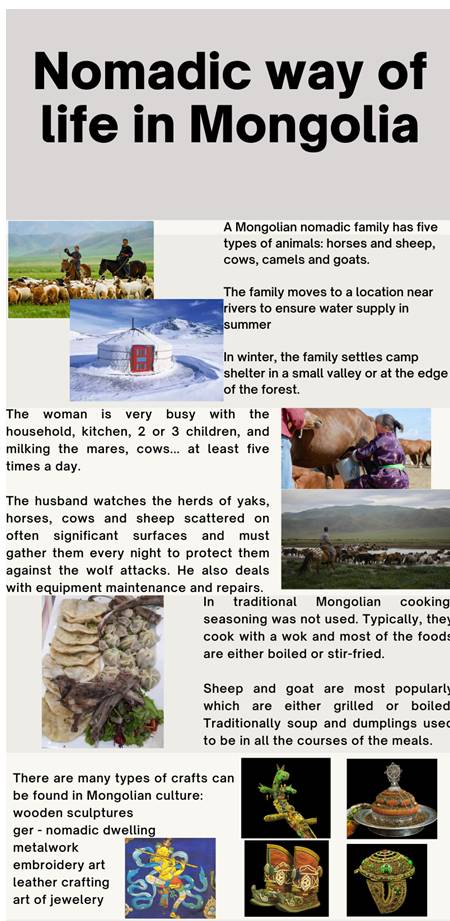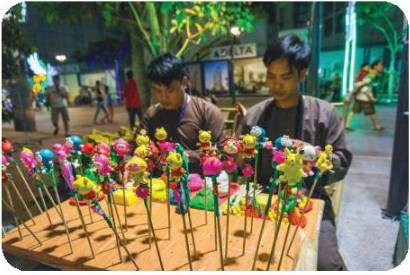Hãy nhập câu hỏi của bạn vào đây, nếu là tài khoản VIP, bạn sẽ được ưu tiên trả lời.

1,
Everyday life: The life of Mongolian is punctuated by caring animals. A Mongolian nomadic family has five types of animals: horses and sheep for hot season and cows, camels and goats for cold season.
Several times during the year, according to the needs of livestock and pasture conditions, nomadic families move their yurts.
In summer, the nomadic family will favor a location near a river, to ensure water supply for the family and herds, and good pastures.
In winter, the priority is given to protection against the intense cold of Mongolian winter, and the family settles its "winter" camp sheltered from the wind in a small valley or at the edge of a forest.
The woman is very busy with the household, kitchen, 2 or 3 children, and milking the mares, cows... at least five times a day.
The husband watches the herds of yaks, horses, cows and sheep scattered on often significant surfaces and must gather them every night to protect them against the wolf attacks, frequent in Mongolia.
He also deals with equipment maintenance and repairs.
Ways of cooking: In traditional Mongolian cooking, seasoning was not used; although salt was there a long time and it is used it even in tea! Typically, they cook with a wok and most of the foods are either boiled or stir-fried.
Since a lot of livestock is raised in Mongolia, it is no mystery that Mongolian cuisine revolves around them. Sheep and goat are most popularly which are either grilled or boiled. Traditionally soup and dumplings used to be in all the courses of the meals, without which, it was regarded to be incomplete.
There are many types of crafts can be found in Mongolian culture: wooden sculptures, ger - nomadic dwelling, metalwork, embroidery art, leather crafting, art of jewelery.
The traditional masterpiece of Mongolian is the urtyn duu accompanied with the morin-khurr. Most famous Mongolian dance are: Jinai dance (milking dance), the Caihong dance (rainbow dance), the Zhongwan dance (bowl dance), the Kuaizi dance (chopsticks dance), and the Andai dance
There are lots of festival in Mongolia but these are the most well-known one: Tsagaan Sar (Lunar New Year); Khovsgol Ice Festival; Naadam Festival; Gongoriin Bombani Hural; Ölgii Eagle Festival.
2,

3,
Hello everyone, today our group will introduce the nomadic way of life in Mongolia. The life of Mongolian family depends on the healths of herds and is punctuated by caring for animals.
Traditionally, a Mongolian nomadic family has five types of animals: horses and sheep, cows / yaks, camels and goats.
Several times during the year, according to the needs of livestock and pasture conditions, nomadic families move their yurts.
In summer, the nomadic family will favor a location near a river, to ensure water supply for the family and herds, and good pastures.
In winter, the priority is given to protection against the intense cold of Mongolian winter, and the family settles its "winter" camp sheltered from the wind in a small valley or at the edge of a forest.
The woman is very busy with the household, kitchen, 2 or 3 children, and milking the mares, cows... at least five times a day.
The processing of dairy products (cream, yogurt, liquor, milk, cheese ...) takes a long time as well.
The husband watches the herds of yaks, horses, cows and sheep scattered on often significant surfaces and must gather them every night to protect them against the wolf attacks, frequent in Mongolia. He also deals with equipment maintenance and repairs.
In traditional Mongolian cooking, seasoning was not used; although salt was there a long time and it is used it even in tea! Typically, they cook with a wok and most of the foods are either boiled or stir-fried. Sheep and goat are most popularly which are either grilled or boiled. Traditionally soup and dumplings used to be in all the courses of the meals.
There are many types of crafts can be found in Mongolian culture: wooden sculptures, ger - nomadic dwelling, metalwork, embroidery art, leather crafting, art of jewelery.
The traditional masterpiece of Mongolian is the urtyn duu accompanied with the morin-khurr. Most famous Mongolian dance are: Jinai dance (milking dance), the Caihong dance (rainbow dance), the Zhongwan dance (bowl dance), the Kuaizi dance (chopsticks dance), and the Andai dance
There are lots of festival in Mongolia but these are the most well-known one: Tsagaan Sar (Lunar New Year); Khovsgol Ice Festival; Naadam Festival; Gongoriin Bombani Hural; Ölgii Eagle Festival. Thanks for listening.

When I was young, I used to go back to my hometown, which is the countryside. It is in Ninh Binh . I really like the fresh air there, the buffaloes grazing on the hills and the friendly people here. I love this rural land. The food here has a strong hometown flavor that makes anyone going away must remember it. For those who like a peaceful life, Ninh Binh is a very ideal place.

Tham khảo:
1. Chau An Village
A: What do people in Chau An Village do to maintain theis traditional lifestyle?
(Người làng Châu An làm gì để gìn giữ lối sống truyền thống của họ?)
B: They perform traditional dances. They also hold festivals.
(Họ biểu diễn những vũ điệu truyền thống. Họ cũng tổ chức các lễ hội.)
2. Dam Ri Village
A: What do people in Dam Ri Village do to maintain their traditional lifestyle?
(Người làng Đạm Ri làm gì để gìn giữ lối sống truyền thống của họ?)
B: They cook and sell traditional food. They also make crafts.
(Họ nấu và bán những món ăn truyền thống. Họ cũng làm đồ thủ công.)
3. Son Ca Village
A: What do people in Son Ca Village do to maintain their traditional lifestyle?
(Người làng Sơn Ca làm gì để gìn giữ lối sống truyền thống của họ?)
B: They weave clothing. They also sing folk songs.
(Họ dệt vải. Họ cũng hát dân ca nữa.)

Choose a festival that you like. Ask and answer the questions about how it is celebrated.
1. What do young children usually do ?
They usually go sightseeing with their family members and get lucky money from adults.
2. What do teenagers and adults usually do ?
They clean and decorate their houses, make special food and visit relatives.
3. Is there any special food ?
Yes, there are, such as: Banh Chung, Banh Day, Spring Rolls,ect...
4. Why do you like this festival ?
Because it's time for my family reunion and I can get much lucky money.

Tay ethnic minority occupies 1st place in the ethnic minorities of Vietnam. While Viet people have 86% of the population, Tay residents have less than 2%. Their number is estimated at approximately 1.7 million. It is estimated, they are in Vietnam already in the year 500 A.D. This group is divided into the another smaller groups (e.g. Ngan, Phen, Tho, Thu Lao, Pa Di). People inhabit the area mainly in the north-eastern part of northern Vietnam, in the provinces of Cao Bang, Lang Son, Bac Kan, Quang Ninh, Ha Giang, in smaller numbers in Yen Bai and Lao Cai.
The culture of the Tay ethnic group is very rich. Starting with traditional folklore and wedding songs, poems, dances and music. The well-known song is “Hat Luon“, it’s called. duet between lovers. During the year, there are a several festivals and celebrations that have different meanings. They are typical farmers and some traditions have persisted to the present. E.g. long tradition in the cultivation of wet rice, digging irrigation canals, threshing grain rice on wooden racks (Loong). The most famous craft of Tay ethnic minority is weaving brocade of original designs, which are highly prized.
Clothes are not so colorful as with other ethnic minorities. Clothes are made of cotton that is dyed indigo color. There is not so much to see the embroidery or other decorations. Women wear skirts or pants, polo shirt and black scarf, men wear trousers and shirt or T-shirt. Thu Lao ethnic minority wears cone-shaped scarf on their heads and Tho ethnic minority dresses like Thai residents of Mai Chau town.
Dwellings are similar to Thai residents, the house is built on the pillars. They use the tiles, straw or palm leaf for building the roof and wood or bamboo for walls. The villages are often built in the foothills and are often named according to mountains, rivers or fields that are located here. Villages are often large and have dozens of homes at once.

Singapore is a bustling international city with many high-rise buildings, parks and culturally rich venues. Singapore is also the intersection of the most quintessential beauty from the East and the West.
Singapore is one of the smallest countries in the world and the smallest country in Southeast Asia. Despite its modest area, but with a free trade economy and high quality workforce. Singapore has really gotten a very solid position in the world.
With a complex population of culture, cuisine, art and architecture, Singapore is a dynamic city, rich in color and contrast. It is not wrong to say that Singapore is the intersection of the most quintessential beauty from the East and the West.
As a country located in Asia, but English is used as the official language in Singapore. English is popularized and brought into education from elementary schools here. Most people can speak this international language. From the smallest things, the traffic signs, direction signs ... all use English, which makes it easier for tourists or foreigners to live and work. For students who are not fluent in English, this is a good opportunity for you to contact the English language 24 / 24h.
In conclusion, I love Singapore so much.



